Llanddarog is a village which sits to the south of the main A48 road between Carmarthen and Cross Hands, about six miles east of Carmarthen. The men of the Parish who fell during the Great War are reportedly commemorated on the war memorial at St. Twrog Church. I presently have no photographs of this memorial, as whenever I have visited the Church has been locked, so the names have been taken from the 1922 published Carmarthen County War Memorial Roll. I have also added details of other men from the parish who I have come across during my work. A photograph of the World War Two memorial has recently been sent to me by Terry Davies, MBE, so that section of this page is accurate.
The Great War, 1914-1918
Sidney Elliott, Private, 203561, Welsh Regiment. Sidney was born at Leicester. By 1911 he was working as a farm hand for William and Eleanor Edwards at Llanddarog. He enlisted at Carmarthen into the Pembroke Yeomanry. Sidney was posted to France, probably during 1917, where he joined the 9th Battalion, Welsh Regiment, attached to 58 Brigade, 19th (Western) Division. In 1917 the Division moved to Ypres from the Somme, taking part in the Battle of Messines, and fought on the Menin Road and at Polygon Wood, before moving up to Broodseinde, Poelcappelle and Passchendaele Village itself. Sidney was wounded early in 1918, and died of his wounds at Rouen on 19 January 1918, aged 22. He is buried at St. Sever Cemetery Extension, Rouen, France. Sidney is not commemorated on the County War Memorial roll.
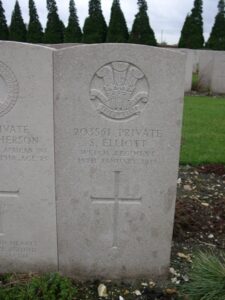
Hugh Bagnall Gething, Second Lieutenant, Royal Gloucestershire Hussars. Hugh was born at Lether Llestry, Llanddarog on 7 October 1883, the Son of James Edward Gething of Siddington Hall, Cirencester, and of Maria Llewellyn, daughter of James Bagnall of Castle Hill House, Carmarthen. Hugh was educated at Harrow and Cambridge, and joined the Royal Gloucester Hussars on 25 March 1911. He volunteered for overseas service at the outbreak of the Great War, and on 15 April 1915 the Hussars sailed to Egypt on board the SS Minneapolis. On 11 August, the Hussars received orders to embark for Gallipoli, and landed at Suvla Bay in August attached to 1st South Midland Brigade, 2nd Mounted Division. The Hussars moved to positions near Chocolate Hill. On 21 August 1915, the Hussars were advancing across open ground, when they came under Turkish artillery fire, and Hugh was killed by shrapnel. He was 31 years old, and was buried at Green Hill Cemetery, Gallipoli. His elder brother James had been killed during the Boer War. Hugh is not commemorated on the Carmarthen County War Memorial Roll.
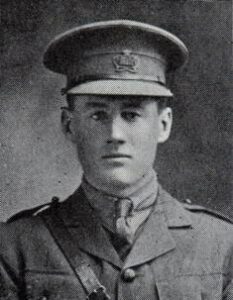
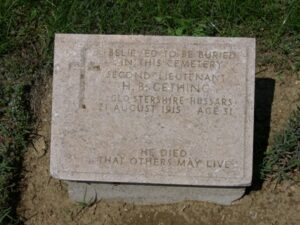
William James, DCM, MM, Corporal, 1728, East Surrey Regiment. William was the son of James and Ann James, of Bryncrwn, Mynyddcerrig, Pontyberem. He enlisted at Tumble into the East Surrey Regiment on 6 September 1914, but was discharged as medically unfit. Undeterred he re-enlisted at Shoreham into the 8th Battalion, East Surrey Regiment, which was attached to 55 Brigade, 18th (Eastern) Division. The Division moved to France in May 1915, and saw its first major action in the Battle of Albert in July 1916. The Division fought throughout the Somme offensive, and in March 1917 followed the German Retreat to the Hindenburg Line. In 1917 the Division took part in the Third Battle of the Scarpe, which was part of the Arras Offensive, then moved to Ypres, where it took part in the Battles of Pilckem, Langemarck, and at the First and Second Battles of Passchendaele. In 1918 the Division were stationed south of the Somme, and were one of the Divisions hit there by the German Spring Offensive, which was launched on 21 March 1918, and fought a heroic rearguard action towards Villers-Brettoneux. William was killed on the Somme on 4 April 1918, aged 25. He is commemorated on the Pozieres Memorial, France. William was a brave man, as he was awarded the Distinguished Conduct Medal and the Military Medal during his time at war.
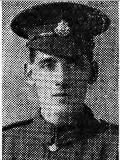

Thomas James Lewis, Private, 509, Welsh Regiment. Thomas was the son of Joseph and Ann Lewis, of Brynhawddgar, Mynyddcerrig, Pontyberem. He enlisted at Carmarthen into the 1/4th Battalion, Welsh Regiment, which was formed during August 1914 in Carmarthen. The Battalion was then attached to 159 Brigade, 53rd (Welsh) Division, and in July 1915 sailed from Devonport for Egypt. On 9 August 1915 the division had moved from Egypt, and landed on Gallipoli. The next few days were chaotic, with small scale battles raging around the Peninsula, and Thomas was killed in action on 12 August 1915. He was 23 years old, and is remembered on the Helles Memorial, Gallipoli.
Gilbert Lewis Lloyd, Second Lieutenant, London Regiment. Gilbert was born at Llansteffan in 1888, the son of Reverend William Reece Lloyd and Emily Elizabeth Lloyd. His father had been the vicar of Llansteffan and Llanddarog prior to his death. Gilbert entered St. David’s College from Lampeter College School in October 1913. He joined the Army Service Corps in 1914, and fought in the ranks on the Somme in 1916 before being commissioned into the London Regiment in May 1917 and posted to the 1/21st Battalion, London Regiment (First Surrey Rifles). The battalion was attached to 142 Brigade, 47th (2nd London) Division. Early in 1917 the Division moved north to Belgium, and took part in the Battle of Messines, and then in November 1917 fought at the Battle of Cambrai. Gilbert was killed at Cambrai on 30 November 1917, aged 29. He has no known grave and is commemorated on the Cambrai Memorial, Louverval, France.

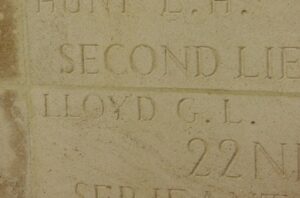
John Morgan, Private, 48946, Welsh Regiment. John was the son of Thomas and Hannah Morgan, of Tyllwyd. The family later moved to Tabor Villa, Cross Hands, and John was a faithful member of Llanddarog Church. John enlisted at Carmarthen into the 10th Battalion, Welsh Regiment, who were attached to 114 Brigade, 38th (Welsh) Division. The Division had landed in France during December 1915 and had spent their first winter in the trenches near Armentieres. In June they marched south to the Somme, where they were tasked with the capture of Mametz Wood. The attack on the wood began on 7 July, but met with fierce resistance, and it took until 14 July to clear the wood. The Division suffered terrible casualties at Mametz, and were taken out of the line, and moved to Ypres to rebuild. Here they fought at Pilckem and Langemarck, where John was killed in action on 19 August 1917, aged 26. He has no known grave, and so is remembered on the Tyne Cot Memorial, Belgium.
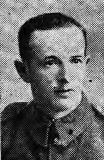
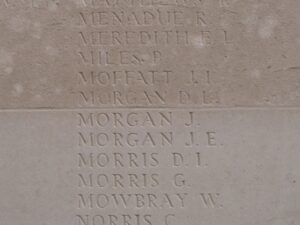
Thomas Morgan, Private, 260301, Border Regiment. Thomas was the Son of David and Ann Morgan, of Penybont, Cwmisfael, Llanddarog. He enlisted in London into the Westmoreland and Cumberland Yeomanry, but was later transferred to the 2nd Battalion, Border Regiment, which was in France attached to 20 Brigade, 7th Division. The Division had been in France since the outbreak of war, and had seen much fighting at Ypres, Loos and the Somme. In March, 1917 they followed up the German Retreat to the Hindenburg Line, and took part in the taking of Bullecourt. Later in the year the Division moved to Ypres, and fought at the Battle of the Polygon Wood. They then took part in the Battle of Broodseinde, the Battle of Poelcapelle and the Second Battle of Passchendaele, but the 7th suffered significant losses during Third Ypres, especially in the fighting for Polygon Wood, the successful advance on 4 October east of the wood, and in the unsuccessful assault south of the Menin Road on 26 October 1917, which is where Thomas was killed that day. He was 26 years old, and is buried at Hooge Crater Cemetery, Belgium.
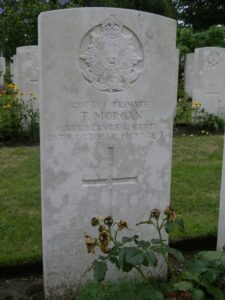
William John Stephens, Private, 13032, Royal Welsh Fusiliers. William was the son of Thomas and Catherine Stephens, of Wern Farm, Llanddarog. He enlisted at Tumble into the 9th Battalion, Royal Welsh Fusiliers, which moved to France in July 1915 attached to 58 Brigade, 19th (Western) Division. The Division moved to positions on the northern end of the Loos Sector, and on the opening of the Battle of Loos, made a brave but disastrous attack on the German lines, incurring heavy casualties. William was one of many men of the 19th Division killed on the opening day of the battle, 25 September 1915. He has no known grave, and is commemorated on the Loos Memorial, France.
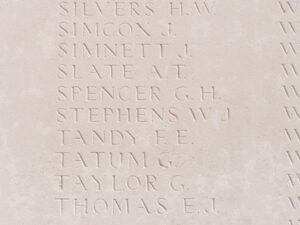
John William Stephenson, Private, 3532, Royal Army Medical Corps. John was born at Barrow. He had moved to West Wales by 1911 to work on the railways, and married Mary Ann Morgan of Llansteffan in 1910. The couple lodged at Llandebie before moving to Tygate, Porthyrhyd, where their son Percy was raised. John enlisted at York at the outbreak of war into the Royal Army Medical Corps, and was posted to France, where he became attached to the 56th Howitzer Battery, Royal Field Artillery. The Battery was attached to the 2nd Division, which had been in France since the outbreak of war, taking part in the retreat from Mons. John would have seen action at Ypres and at Loos, and was awarded the French Legion of Honour for the Somme in 1916. He was mortally wounded around the time of the Third Battle of Ypres, and died of his wounds on 10 August 1917, aged 32. John is buried at La Gorgue Communal Cemetery, France. His widow Mary moved back to Reservoir Cottage, Llansteffan with their son Percy and died there in 1932. John was awarded the French Croix-de-Guerre just prior to his death.

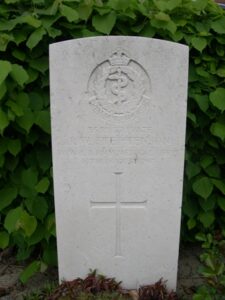
David Thomas, Private, 32295, East Lancashire Regiment. David was the son of John and Mary Thomas of Garn Ffrwd, Mynydd Cerrig, Pontyberem. He enlisted at Cardiff into the 2/1st Monmouthshire Regiment, which were attached to 205 Brigade, 68th Division. The Division remained in the UK on Home Service for the duration of war, but David transferred to the 1st Battalion, East Lancashire Regiment, which had been in France since 22 August 1914 attached to 11 Brigade, 4th Division. They had fought at Le Cateau, the Marne and the Aisne, and also at Messines in 1914 where they took part in the famous Christmas Truce. In 1915 they fought at Second Ypres, and in 1916 at Albert and Le Transloy during the Somme Offensive. Spring 1917 saw them at Arras, where they fought at the Battles of the Scarpe, and they then moved to Ypres, where they fought in the Battle of Polygon Wood, and at Broodseinde, where David was killed in Action on 4 October 1917 aged 30. He is remembered on the Tyne Cot Memorial, Belgium.
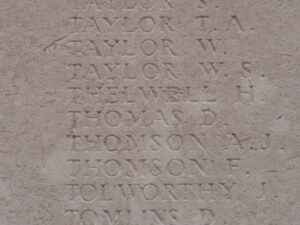
World War Two, 1939-1945
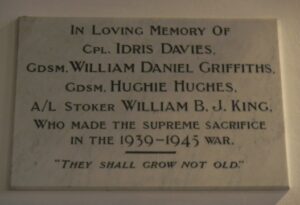
Idris Davies, Corporal, 3976296, Welch Regiment. Idris was the son of David Beynon Davies and Jane Davies of Llanwrcwrt, Pontyberem. He married Rachel Sarah Gibbon, of Llwynhenry, Llanarthe, in 1941. Idris served in the 4th Battalion, Welch Regiment, the local Territorial Battalion, which was attached to the 53rd (Welsh) Division. The Division spent much of the war on home service, first in Northern Ireland, then in southern England and landed at Arromanches at the end of June 1944. The division then fought through the Battle of Normandy, taking part in the drive through northern France into Belgium, and through Holland in 1944. Idris was killed in action during the Battle of s’Hertegonbosch on 24 October, 1944. He was 32 years old, and was buried the following day at Uden War Cemetery. Idris is also commemorated on the war memorial at Mynydcerrig.
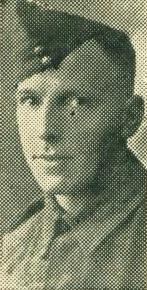
David Lewin Evans, Third Officer, Merchant Navy. David was the son of Llewellyn and Mary Evans, of Llanddarog. He served with the Merchant Navy, aboard the S.S. Westbury, a London registered cargo steamer. On the morning of 12 February 1941, SS Westbury was part of the unescorted convoy SLS.64 when she was attacked by shellfire from the German heavy cruiser Admiral Hipper, about 300 miles S.E. of the Azores. David, the Master, and three other crew members lost their lives during the attack, and are commemorated on the Tower Hill Memorial, London. David was 34 years old. David does not appear to be commemorated locally.
William Daniel Griffiths, Guardsman, 2734326, Welsh Guards. William was the son of Isaac and Elizabeth Griffiths, of Llanddarog. He was a pre-war regular in the army, serving with the 1st Battalion, Welsh Guards at the outbreak of war, and was stationed at Gibraltar. The battalion sailed for France on 7 November 1939, and entrained for Arras, being given the task of guarding the city which had seen so much fighting in the previous war. William was killed in France on 15 December 1939, before the main German attacks on Arras. He was 21 years old, and is buried at Bienvillers Military Cemetery, France.
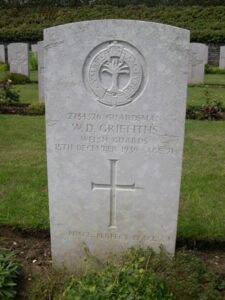
Hughie Hughes, Guardsman, 2735195, Welsh Guards. Hughie served with the 3rd Battalion, Welsh Guards. The battalion formed at Beavers Camp, Hounslow on 24 October 1941 and embarked for North Africa on 5 February 1943, landing in Algiers eleven days later to join the 8th Army. The battalion entrained to El Aroussa, twenty miles south of Medjez El Bab, where it joined the 1st Guards Brigade on 1 March. The battalion saw its first action during the capture of the Fondouk Gap which helped push the Afrika Korps into full retreat. The battalions next action occurred on 8 May, when it supported the attack of the 6th Armoured Division upon the town of Hammam Lif. The attack was successful, but Hughie was among 24 men killed and 50 wounded from the battalion during the day. Hughie was 26 years old and is buried in Enfidaville War Cemetery. He is also commemorated on the Ammanford war memorial.
William Benjamin James King, Leading Stoker, D/KX 90551, Royal Navy. William was the son of David King, and of Rachel Ann King, of Drefach. He was a regular in the Royal Navy, and served aboard HMS Repulse, a Renown Class Battlecruiser. She had seen action during the Great War, and took part in the Norwegian campaign during the early part of the Second War. From October 1941, Repulse was attached to East Indies Command, and formed part of Force Z, alongside H.M.S. Prince of Wales, which was meant to deter Japanese aggression in the Far East. Sadly the Royal Navy under-estimated the power of air attack, and on 10 December 1941, both Repulse and Prince of Wales were sunk by Japanese bombers off Malaya, with huge loss in life. William was one of 508 men lost aboard Repulse that day. He was 23 years old, and is commemorated on the Plymouth Naval Memorial, Devon.